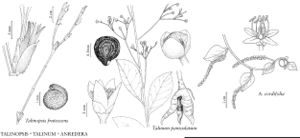Talinopsis
Smithsonian Contr. Knowl. 3(5): 14. 1852.
| Taxon | Illustrator ⠉ | |
|---|---|---|
 | Talinopsis frutescens Talinum paniculatum Anredera cordifolia | Barbara Alongi Barbara Alongi Bee F. Gunn |
Subshrubs. Roots tuberous. Stems branching, suffrutescent, glabrous except at nodes; young branches slender, nodes dilated, tufted-pubescent. Leaves opposite, sometimes in axillary fascicles, sessile; blade subterete, fleshy, margins entire. Inflorescences lateral, cymose, few-flowered, axes angled; peduncle short. Flowers sessile; sepals persistent, distinct; petals fugacious, 5, distinct; stamens 20–25, distinct, anther 2-locular, oblong; gynoecium 3-carpellate, ovary superior, placentation free-central, style 1, stigmas 3, dilated. Fruits capsular, longitudinally dehiscent from apex; valves persistent; exocarp and endocarp evidently differentiated and separating; exocarp 3-valved, valves recurving; endocarp 6-valved, valves erect. Seeds many, uncinate to arcuate, small, estrophiolate; seed-coat granulate, pellicle absent.
Distribution
sw United States, n Mexico
Discussion
Species 1.
A cladistic analysis of chloroplast ndhF sequence data (W. L. Applequist and R. S. Wallace 2001) indicated that Talinopsis is closely related to representatives of Anacampseros Linnaeus and Grahamia Gillies ex Hooker & Arnott (as originally suggested by A. Gray), in a clade not far removed from Talinum but fairly distant from the one that includes Phemeranthus mengesii and presumably the other species of that genus (except perhaps P. aurantiacus, which see).